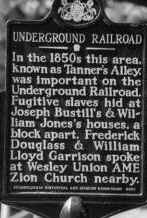|

Events
and News |
Stanley Harrold, Subversives: Anti-Slavery Community in Washington, D.C.,
1828-1865 (Louisiana State University Press, 2003), examines the biracial
nature of antislavery and reform in Washington, D.C. before and during the
Civil War. This book, taken with Katharine Grover, The Fugitive's
Gibraltar: Escaping Slaves and Abolitionism in New Bedford, Massachusetts
(University of Massachusetts Press, 2001) present evidence of self-aware
Underground Railroad networks available to assist freedom seekers. While
Larry Gara's Liberty Line (1961) may have been a necessary corrective to
the overly mythologized accounts of the Underground Railroad, with its
cautions about the unreliability of many of the stories, particularly, I
should add, those written in the 20th century after the passing of those
with living memories of slavery, it may have done its job of debunking a bit
too thoroughly. Though not every "self emancipated" fugitive sought the
help of, or even knew about the existence of, an underground railroad, it
does seem increasingly clear that such organizations existed at least in
particular times and places.
Leslie M. Harris, In the Shadow of Slavery: African Americans in New York
City, 1626-1863 (University of Chicago Press, 2003), while more broadly
focused than Stanley Harrold's Subversives, is an excellent study of a
community, particularly useful for the analysis of the interactions between
various white-led reform and benevolent organizations, the African-American
community and its leadership, and city government.
Carol Faulkner, Women's Radical Reconstruction: The Freedmens Aid Movement
(University of Pennsylvania Press, 2004), focuses on the experiences of
Northern women, veterans of the anti-slavery campaign and often of the
closely related woman's rights movement. Emily Howland, a Quaker from
upstate New York (with family ties to the Underground Railroad), who
appears in Harrold's book as a teacher in a school for African-Americans in
Washington before the Civil War, reappears as part of the reconstruction
movement--just one of many examples of the continuum between pre-Civil War
abolitionism and post war concerns for the education and civil rights of
the newly freed people. As with the Harris book, Faulkner explores the
dynamics of group, racial and gender relations.
Harriet Tubman occupies a curious place in contemporary public history.
Although now one of the most recognizable African-American and Underground
Railroad figures, she is known primarily though the highly romanticized and
embellished books of her first biographer, Sarah Bradford, and from the
many contemporary children's and young adult books that derive from
Bradford's biographies. There hasn't, until now, been a full length,
historically rigorous treatment of Tubman since Earl Conrad's biography
published sixty years ago. Jean M. Humez, Harriet Tubman: The Life and Life
Stories (University of Wisconsin Press, 2003), has examined the sources on
Tubman to both recover the person behind the stories, and to see how
Tubman's biography was constructed and reconstructed over the past century
and a half. The book is excellent reading, both for presenting the
evidence on Tubman's life and for the analysis of how that life has been
portrayed. We are anticipating the publication of yet another book on
Tubman, Kate Clifford Larson's Bound for the Promised Land by the end of
this year. Because of the difference in approaches between the two
scholars, both of whom appear to be careful and conscientious researchers,
it seems highly likely that the Larson and Humez volumes will compliment
each other rather than compete. My understanding is that there are other
books on Tubman in the works. Though the current scholarship may burn away
some of the myth that has been built up around Tubman's activities, the
person who remains is truly heroic, not just for her repeated trips into
the Eastern Shore of Maryland, but for her career for almost fifty years
after the Civil War in Auburn, New York, to ensure the welfare of its
African-American citizens.
Christopher Densmore, December 05, 2003
Friends Historical Library
|
